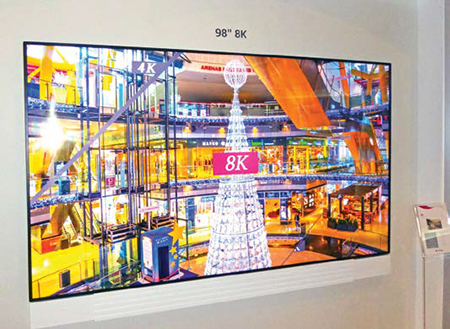Displays Get Bigger and Brighter at 2015 CES
LAS VEGAS—Of all the consumer electronics gadgets shown at CES every year, televisions have generated the most buzz, and it’s been that way for almost two decades. However, given the three-year slump in TV shipments and plummeting prices for ever-larger screen sizes, it was fair game to wonder if this year the television business had finally lost its mojo, taking second place to products like mobile phones, tablets, fitness monitors, and even major appliances after last year’s show.

LG Electronics demo-ed a 98-inch 8K LCD display in its CES booth. Turns out; there were still a few tricks left in the TV bag! Ultra HD (3840x2160) televisions were everywhere at CES, and I do mean everywhere. Sharp, Sony, Samsung, and LG all had a bevy of big 4K TV screens out for inspection, and so did the fast-growing Chinese brands Hisense, TCL, Haier, and Changhong. Even second-tier brands like Westinghouse and JVC announced Ultra HD TV lineups.
OLED INCREASES PRESENCE
Not only was there a plethora of Ultra HD products in the convention center, they showed up in unusual screen sizes (75, 88, 98, 104, and 120 diagonal inches), unusual screen shapes (21:9 “5K” models) and of course, curved LCD and organic light-emitting diode (OLED) TVs. While the LCD models were expected, the OLEDs were not. But LG Electronics has decided they’re all-in with OLED technology and anted up by showcasing seven 4K models at CES, one of which measured 77 inches diagonally and had a flexible screen—tap the remote, and you could flatten or curve it to suit your whim.
Right now, LCD technology is on the top of the heap, accounting for almost 93 percent of all television shipments worldwide in 2013. Still, LCD displays are challenged to provide consistent picture quality when viewed from any angle, not to mention high contrast and low black levels. And that’s where OLED TVs come in: They’re emissive displays, just like the late, lamented plasma TVs. But they can operate at much lower voltages than plasma and come smoothly out of jet black, producing bright, saturated colors with high dynamic range.
The problem with OLED displays of any kind has been manufacturing yields, which for years were well below 20 percent. But LG claims they are now seeing yields of 70 percent or better for their white OLED process. (These OLEDs are combined with color filters to produce RGB images.) Samsung also introduced an OLED TV last year, but quietly pulled it from retail a few months later, most likely due to low yields.
LG’s display manufacturing subsidiary has ramped up OLED production so much that they’re now selling panels to the aforementioned Chinese brands, mostly in the flat profile. But the Chinese made a decision over a year ago to focus on super-sized Ultra HDTVs in their own factories, relying primarily on LCD technology. Some of these factories also manufacture panels for mainstream Japanese and Korean brands: Samsung is a joint partner with TCL in a factory in Shenzen, China that makes 85-inch and 110-inch 4K LCD panels.
While LCD technology is mature, its back-lighting architecture is in flux. Over the past decade, TV manufacturers shifted away from cold cathode fluorescent lamps (CCFL) to inorganic light-emitting diodes (LED) to achieve more stable color, longer operating life, and super-thin televisions.
The professional video industry's #1 source for news, trends and product and tech information. Sign up below.
QUANTUM DOTS
With the advent of high dynamic range movie and TV acquisition and production, plus the new and wider ITU BT.2020 color space, the limitations of white LEDs coupled to color filters became quickly apparent. A new technology, quantum dots, is now being put to work to “pump up” both image brightness and color saturation.
Sony’s Triluminous Ultra HD sets have had quantum dots in them for two years now. At CES, those models were joined by Samsung (Super UHDTV), LG, TCL, Sharp, Changhong, and Haier. Some of these manufacturers use QD light pipes manufactured by Boston-based QD Vision; 3M is also a player in this market with their QD film (manufactured with Nanosys), but so far, their customers are limited to computer manufacturers.
So many TV brands showed HDR TVs this year that the thrill wore off quickly. One problem for HDR is that all of the standards aren’t in place yet (not to mention display interfaces that are sufficiently fast enough), and TV manufacturers gotta sell product! Although Ultra HDTV sales have been better than expected this year, they’re still not moving fast enough—hence, the announcement at the show of the UHD Alliance, a consortium of TV manufacturers (Samsung, Panasonic, Sony), content providers (Fox, Disney, Warner Bros., Netflix, DirecTV), and ancillary manufacturers (Dolby, Technicolor). Their goal is to move things along and hasten the transition from “old-fashioned” 2K HDTV to the new world of 4K, HDR, and beyond.

Sharp demo-ed its Quantum Dot technology at its booth.4K AND BEYOND
Speaking of “beyond,” there were at least five demonstrations of 8K television at the show, and the most intriguing of all spotlighted the Super MHL interface. Short for “Mobile High-Definition Link,” MHL is a way to run HDMI connections over the five-pin micro USB jack found on some tablets and smartphones.
Until now, MHL could only show a 2K image, but the new “Super” iteration features a much higher data rate (32 Gbps), plus a much larger connector, which leads one to wonder why HDMI 2.0 is needed anymore. This demo featured a Samsung 88-inch 8K TV driven through a Super MHL connection. Other 8K demos were found in the Panasonic booth (55-inch TV), LG Display (98-inch), LG (again, 98-inch) and Sharp (85-inch). Yes Virginia, there is definitely a whole new world beyond 4K!
Finally, for those patiently twiddling their thumbs, the official announcement of the 4K Blu-ray standard was made at CES, but don’t count on seeing it until the end of this year. Disc capacity will likely increase to 66 GB for single layer and 100 GB for dual-layer versions, with streaming rates exceeding 100 Mbps using HEVC H.265 coding. Panasonic was the only company to show a prototype Ultra HD Blu-ray player at the show and it was streaming at about 108 Mbps. We can hardly wait…
Pete Putman, CTS, KT2B, is the president of ROAM Consulting.

